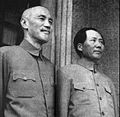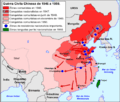Chinese Civil War facts for kids
The Chinese Civil War was a long fight in China between two main groups: the Communist Party of China (CCP) and the Kuomintang (KMT), also known as the Nationalists. This war lasted from 1927 to 1951. Both groups wanted to be the official government of China.
The war started in April 1927, partly because of something called the 'Northern Expedition'. Most of the big battles ended in 1950. However, some people say the war isn't truly over because no peace agreement was ever signed. Today, the Republic of China (ROC), which is now Taiwan, and the People's Republic of China (PRC) both still claim to be the real government of all China. This makes their relationship difficult. The Chinese Civil War was one of the biggest wars in history, after World War II and World War I.

The fighting stopped and started many times, even during the Second Sino-Japanese War (when China fought against Japan). After Japan was defeated in World War II, the civil war between the CCP and KMT began again in 1946.
The CCP eventually took control of most of mainland China. The KMT only held onto some islands. Around two million Chinese people moved to Taiwan in late 1949. By 1950, no major battles were happening anymore.
The KMT lost control of mainland China for several reasons:
- The Yan'an Rectification Movement helped Mao gain more power within the CCP.
- A ceasefire (a stop to fighting) arranged by a United States officer in 1946 temporarily stopped the KMT's progress.
- There were many problems between the people and the KMT in areas the KMT controlled.
- The Soviet Union gave weapons from the defeated Japanese army to the CCP.
- The United States did not always give strong support to the KMT.
Since no official peace agreement was made, some people believe the war is still technically ongoing. Both sides still have many military weapons ready to use against the other. Both still claim to be the only true government of China. Each side also tries to have official relationships with other countries as the only legitimate government.
Before the War
After the Qing dynasty fell in the 1911 Xinhai Revolution, China was in chaos. Many powerful local leaders, called warlords, took control of different parts of the country. To defeat these warlords and unite China, Sun Yat-sen and the KMT looked for help from other countries.
Sun Yat-sen asked several Western countries for help, but none offered any. It was only when he turned to the Soviet Union in 1921 that he found support. The Soviet Union, which was a communist country, agreed to help the KMT. But they had one condition: the smaller Communist Party of China (CCP) had to be allowed to join with the KMT.
In 1923, the Soviet Union, KMT, and CCP made an agreement called the Sun-Joffe Manifesto. This agreement stated that the Soviet Union would help China become one united country, instead of many small areas controlled by warlords. A Soviet adviser named Mikhail Borodin came to China in 1923. He helped change the KMT to be more like the Communist Party of the Soviet Union. This joining of the CCP and KMT was known as the First United Front.
In 1923, Chiang Kai-shek traveled to the Soviet Union to learn about military and political ideas from the Soviet Communist Party. In 1924, he became the leader of the Whampoa Military Academy in China. Most of the Soviet Union's help went to this school. The academy taught both KMT and CCP members about Soviet political and military ideas. The Soviet Union provided books and weapons for military training. With this help, Sun Yat-sen created an "army of the party." Members of the CCP were also part of the school, and some were even teachers, like Zhou Enlai.
During this time, the KMT allowed some communists to join their party. The CCP was much smaller than the KMT back then. In 1922, the CCP had only 300 members, and by 1925, it had grown to 1,500. In comparison, the KMT had 50,000 members in 1923.
Images for kids
-
Republic of China FT tanks
-
Mao Zedong's proclamation of the founding of the People's Republic in 1949
-
Generalissimo Chiang Kai-shek, Commander-in-Chief of the National Revolutionary Army, emerged from the Northern Expedition as the leader of the Republic of China
-
Chinese Communist soldiers march north to occupy rural Manchuria, 1945.
See also
 In Spanish: Guerra civil china para niños
In Spanish: Guerra civil china para niños
























